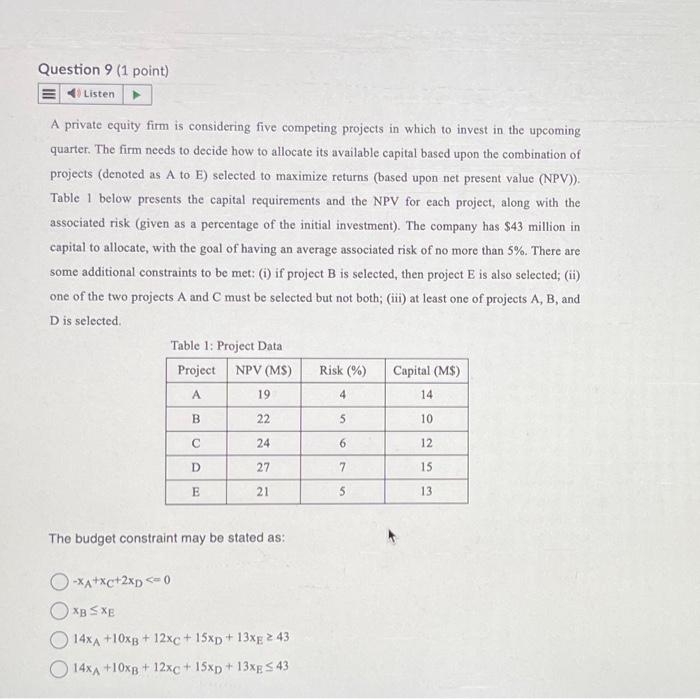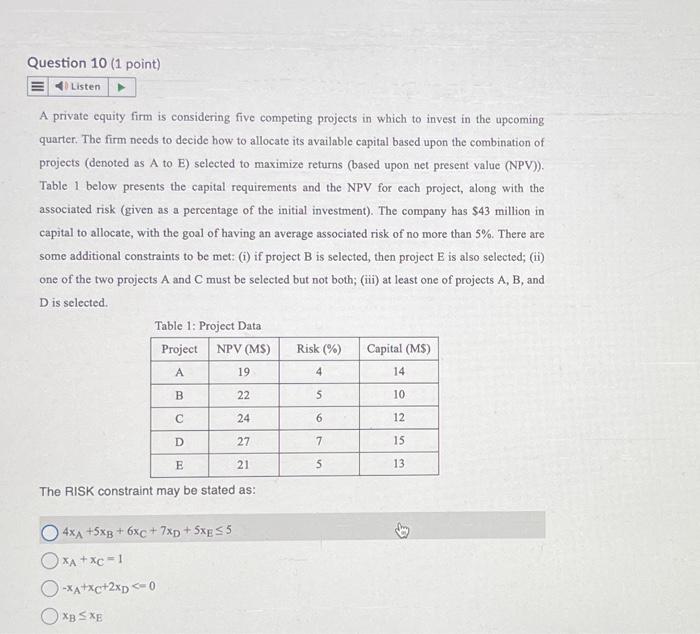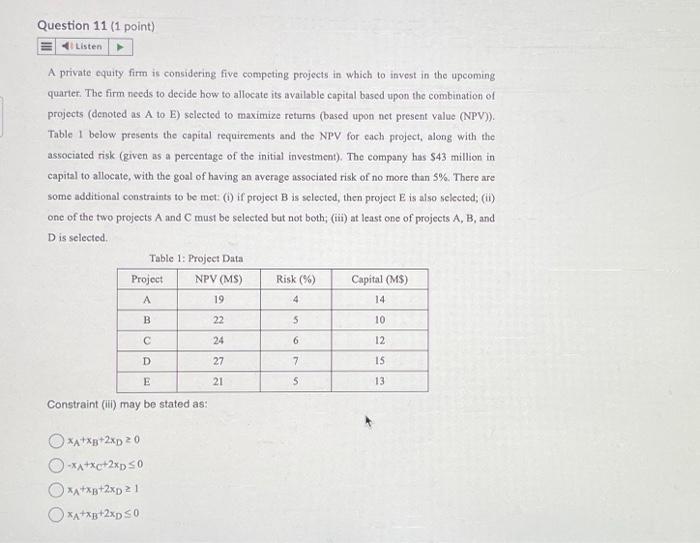Answered step by step
Verified Expert Solution
Question
1 Approved Answer
App stat For Questions 7-11 A private equity firm is considering five competing projects in which to invest in the upcoming quarter. The firm needs
App stat 



 For Questions 7-11 A private equity firm is considering five competing projects in which to invest in the upcoming quarter. The firm needs to decide how to allocate its available capital based upon the combination of projects (denoted as A to E) selected to maximize returns (based upon net present value (NPV)). Table 1 below presents the capital requirements and the NPV for each project, along with the associated risk (given as a percentage of the initial investment). The company has $43 million in capital to allocate, with the goal of having an average associated risk of no more than 5%. There are some additional constraints to be met: (i) if project B is selected, then project E is also selected; (ii) one of the two projects A and C must be selected but not both; (iii) at least one of projects A, B, and D is selected. Table 1: Project Data The restrictions related to the nature of the decision variables are: xA,xB,xC,xD,xE0 x1,x2,x3,x4,x5 are real numbers xA,xB,xC,xD,xE0, integer xA,xB,xC,xD,xE= binary variables A private equity firm is considering five competing projects in which to invest in the upcoming quarter. The firm needs to decide how to allocate its available capital based upon the combination of projects (denoted as A to E) selected to maximize returns (based upon net present value (NPV)). Table 1 below presents the capital requirements and the NPV for each project, along with the associated risk (given as a percentage of the initial investment). The company has $43 million in capital to allocate, with the goal of having an average associated risk of no more than 5%. There are some additional constraints to be met: (i) if project B is selected, then project E is also selected; (ii) one of the two projects A and C must be selected but not both; (iii) at least one of projects A, B, and D is selected. Table 1: Proiect Data The objective function is: Max4xA+5xB+6xC+7xD+5xE43Max19xA+22xB+24xC+27xD+21xEMin14xA+10xB+12xC+15xD+13xB43Min19xA+22xB+24xC+27xD+21xE A private equity firm is considering five competing projects in which to invest in the upcoming quarter. The firm needs to decide how to allocate its available capital based upon the combination of projects (denoted as A to E) selected to maximize returns (based upon net present value (NPV)). Table 1 below presents the capital requirements and the NPV for each project, along with the associated risk (given as a percentage of the initial investment). The company has $43 million in capital to allocate, with the goal of having an average associated risk of no more than 5%. There are some additional constraints to be met: (i) if project B is selected, then project E is also selected; (ii) one of the two projects A and C must be selected but not both; (iii) at least one of projects A,B, and D is selected. Table 1: Proiect Data The budget constraint may be stated as: xA+xC+2xD
For Questions 7-11 A private equity firm is considering five competing projects in which to invest in the upcoming quarter. The firm needs to decide how to allocate its available capital based upon the combination of projects (denoted as A to E) selected to maximize returns (based upon net present value (NPV)). Table 1 below presents the capital requirements and the NPV for each project, along with the associated risk (given as a percentage of the initial investment). The company has $43 million in capital to allocate, with the goal of having an average associated risk of no more than 5%. There are some additional constraints to be met: (i) if project B is selected, then project E is also selected; (ii) one of the two projects A and C must be selected but not both; (iii) at least one of projects A, B, and D is selected. Table 1: Project Data The restrictions related to the nature of the decision variables are: xA,xB,xC,xD,xE0 x1,x2,x3,x4,x5 are real numbers xA,xB,xC,xD,xE0, integer xA,xB,xC,xD,xE= binary variables A private equity firm is considering five competing projects in which to invest in the upcoming quarter. The firm needs to decide how to allocate its available capital based upon the combination of projects (denoted as A to E) selected to maximize returns (based upon net present value (NPV)). Table 1 below presents the capital requirements and the NPV for each project, along with the associated risk (given as a percentage of the initial investment). The company has $43 million in capital to allocate, with the goal of having an average associated risk of no more than 5%. There are some additional constraints to be met: (i) if project B is selected, then project E is also selected; (ii) one of the two projects A and C must be selected but not both; (iii) at least one of projects A, B, and D is selected. Table 1: Proiect Data The objective function is: Max4xA+5xB+6xC+7xD+5xE43Max19xA+22xB+24xC+27xD+21xEMin14xA+10xB+12xC+15xD+13xB43Min19xA+22xB+24xC+27xD+21xE A private equity firm is considering five competing projects in which to invest in the upcoming quarter. The firm needs to decide how to allocate its available capital based upon the combination of projects (denoted as A to E) selected to maximize returns (based upon net present value (NPV)). Table 1 below presents the capital requirements and the NPV for each project, along with the associated risk (given as a percentage of the initial investment). The company has $43 million in capital to allocate, with the goal of having an average associated risk of no more than 5%. There are some additional constraints to be met: (i) if project B is selected, then project E is also selected; (ii) one of the two projects A and C must be selected but not both; (iii) at least one of projects A,B, and D is selected. Table 1: Proiect Data The budget constraint may be stated as: xA+xC+2xD
App stat 





Step by Step Solution
There are 3 Steps involved in it
Step: 1

Get Instant Access to Expert-Tailored Solutions
See step-by-step solutions with expert insights and AI powered tools for academic success
Step: 2

Step: 3

Ace Your Homework with AI
Get the answers you need in no time with our AI-driven, step-by-step assistance
Get Started


